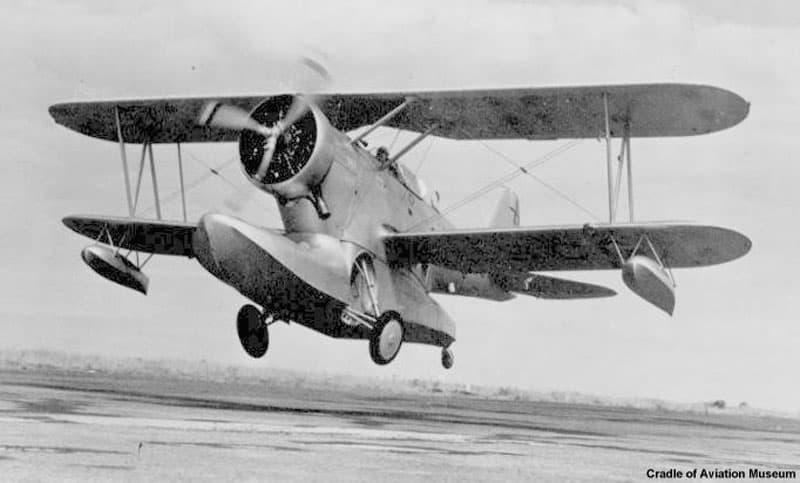Grover Loening formed his own company in 1928 when the original Loening Aeronautical Engineering Corporation combined with Curtiss-Wright. Grover submitted plans for a privately developed XO2L-1 amphibian to the Navy and requested evaluation. This amphibian retained many of the Loening OLs features but presented them in a more streamlined design. It was received well but Grover Loening did not have adequate facilities for production. Following the Curtiss Wright take-over a talented group of Loening employees that included Leroy Grumman and Albert Loening left and formed the Grumman Aircraft Engineering Corporation. Grumman had facilities and at the Navy’s suggestion began redesign work on the XO2L-1 with the idea of producing the amphibian.

In 1931 the Navy reassigned the aircraft designator “J” from transport aircraft to designate a new type of utility aircraft. In the Navy system, in effect at the time, the Manufacturer was also designated with a letter. Grumman became “F.” The reason for the selection of the letter “F” to represent Grumman is vague but most probably it reflected the fact that there are only 26 letters in the alphabet, “G’ was taken by Goodyear, “F” was not in use at the time, and therefore “F” was selected. Thus the XO2L became the XJF-1. The 1 designated the first configuration. At a later date, when significant modifications had been made, the aircraft in reality became the second in a line of utility amphibians manufactured by Grumman and the designation became J2F- and was followed by a configuration number. The XJF-1 was a compact, single bay biplane with a crew of two, seated in tandem under a fully enclosed canopy. It was powered by a Pratt & Whitney R-1830-62 fourteen cylinder air-cooled engine that drove a three-blade Hamilton Standard propeller. It carried a 100 pound bomb under each lower wing and a .30 caliber machine gun operated from the rear cockpit. The JF-1 Grumman was ordered into production in 1934. The navy issued a contract for 27 JF-1s. While the provision for armament was retained, the armament itself was usually deleted and a third position was added for a radio operator. Named the “Duck”, the JF-1 would evolve through six major variants.
The JF-2 was built in 1934-35 as an unarmed utility aircraft for the US Coast Guard. JF-2s differed from the JF-1 in that they were powered by a 700hp Wright R-1820-102 nine cylinder engine with a narrow chord cowling. Externally, the JF-2s were easily identified by the radio direction finder loop antenna installed on the fuselage spine behind the canopy and the lack of arresting gear. The Coast Guard ordered 14 JF-2s. The JF-2s served ashore at air stations and were carried on board Coast Guard cutters designed to carry aircraft. They were utilized on Bering Sea patrols and on board cutters participating in the Greenland Patrol. Elmer Stone and Richard Burke took advantage of the amphibian’s excellent performance to establish three new world records for amphibians. One JF-2 was traded to the Marine Corps for a Lockheed R30-1 executive transport and at the beginning of WWII four were traded to the Navy in exchange for four Naval Aircraft Factory N3N-3s that were used for preliminary flight training at the Charleston air station.
Production of the JF was halted in March of 1936 and an entirely new series was ordered. The revised design was given the Navy designation J2F. Grumman produced six modifications in this series. During WWII, ten Navy J2F-4/5/6s were assigned for Coast Guard use. The final mission for the “Duck” in Coast Guard or Navy service came in 1946 and 1947. A J2F-6, assigned to the Coast Guard ice-breaker Northwind, participated as part of Navy Task Force 68, an Antarctic Expedition named Operation HIGH JUMP. The “Duck” was responsible for making reconnaissance flights over the South Pole region, weather reconnaissance, liaison and supply flights and acting as standby rescue and medical evacuation aircraft. The J2F-6 and the crew of the Northwind won the praise of the Commander Task Force 68, receiving much of the credit for the success of supporting operations for the scientific programs.

| Manufacturer Grumman |
Fuel Capacity 150 gallons |
|
Designation JF-2 |
Range 759 miles |
|
Type Utility Amphibian |
Top Speed 176 mph |
|
Wing Span 39 ft. |
Cruise Speed 155 mph |
|
Length 34 ft. |
Stall Speed 67 mph |
|
Gross Weight 5800 pounds |
Engine 775hp Wright R-1820-102 |
|
Service Ceiling 18,500 ft |
Propeller Hamilton Standard 3-bladed |

